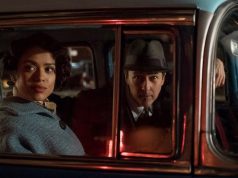Sexuality is such a prevalent theme in today’s culture that it’s hard to see why Alfred Kinsey’s research on it caused such a big stir in the 1940s. The film “Kinsey” paints a portrait of a complex, socially awkward man whose personal feelings played only a small role in his clinical studies, a man who was simply curious to know what people were thinking (or, more to the point, doing).
In “Kinsey,” written and directed by Bill Condon (“Gods and Monsters”), we are given a view of early-20th-century morality that is somewhere between quaint and frightening. Kinsey’s father (played by John Lithgow, reliving his “Footloose” sanctimony), a small-town moral tyrant, preaches that “the modern inventions of science have been used to cultivate immorality” — the same argument that very sensible people today make about Internet pornography and such, except that HE’S talking about inventions like electricity and the telephone. The worst one of all, according to Alfred Kinsey Sr.? You’ll never guess. It’s the zipper, because it gives “men and boys speedy access to moral oblivion.”
Raised in this environment, Dr. Kinsey himself (played as an adult by Liam Neeson) is the very picture of sexual ignorance and repression, but as a budding scientist, he has a natural curiosity. He becomes a biologist, and a bookish one at that, spending 11 months in solitude looking for a particular breed of wasp. He eventually gathers 500,000 specimens. Even if a guy like that WANTED to have sex, what are the chances he could?
While teaching at the University of Indiana, Kinsey meets Clara McMillen (Laura Linney), his soulmate, a woman perhaps as nerdy as he is. When they get married, he gives her an ancient gall wasp trapped in amber. She declares it the perfect gift.
Kinsey begins teaching a course at the university designed to help students in early marriage, and he is amazed at the misinformation with which otherwise intelligent students are saddled. Sex is never discussed in decent society, and when it is discussed, it is often discussed erroneously. Kinsey theorizes that there is a huge gap between what society assumes people do and what people actually do, and so he sets out to find out, scientifically, what people actually do.
Aided by a team that includes Peter Sarsgaard as a bisexual grad student and Chris O’Donnell and Timothy Hutton as research assistants, Kinsey interviews thousands of people around the country about their sexual histories, training his staff rigorously beforehand so the interviews will be objective, non-judgmental and accurate. The results are published in “Sexual Behavior in the Human Male,” which fast becomes a bestseller.
The book raises the expected controversy, both from priggish academics at U. of Indiana (including one played by Tim Curry), and from religious organizations. Kinsey is frustrated and perplexed by this. His honest intention was simply to report on what was happening in America, not to suggest what people SHOULD be doing. He leaves morality out of it, saying that if lots of people are doing something, then a person shouldn’t feel perverted or freakish for doing it, because it’s obviously natural. To him, it’s all biology.
Kinsey himself is “open” almost to an alarming degree, and you should hear the conversations had at the Kinsey family dinner table. It’s 2004, and I’m not a prude, and I was taken aback to hear such things discussed so openly — which I suspect is what Condon had in mind, to show that in some ways, American society is no more open about sexuality now than it was in the 1940s.
The question of whether Kinsey’s work did more harm or good for society is beyond the scope of a movie review, and it’s irrelevant in terms of discussing the film’s artistic merits, which are many. I can tell you that the movie supports Kinsey’s research, especially insofar as it opened doors for homosexuals to feel less self-loathing and more acceptance, homosexuality being one of the major things that made people feel alone and freakish in those days. (Condon is gay, which may explain, at least in part, his interest in Kinsey to begin with.)
Did Kinsey’s telling the world what everyone was already doing make people do it more? Did general acceptance of the things that people were already doing secretly make people who were not already doing those things start doing them? Are there some things that SHOULDN’T be accepted, no matter how common they are? Of course there are. The question is whether the things most widely uncovered in Kinsey’s research as being more common than everyone thought — homosexuality and masturbation — are among them. Your views on that matter may determine, to some extent, your enjoyment of the film.
Neeson, a consummate actor, strangles his Irish accent into near-submission and gives a surprisingly nuanced performance as Kinsey. Ever the scientist, Kinsey seems to eschew such incalculable things as “love,” but his relationship with Clara — as odd as it can be at times — is ultimately warm and loving, the emotional balance to all of Kinsey’s clinical work.
Laura Linney has a thankless role, that of the supportive woman who stands by her obsessed, brilliant man (see also Jennifer Connelly in “A Beautiful Mind,” Marcia Gay Harden in “Pollock”), but she does it stoically and with grace. She does a mean John Lithgow impression, too, as we discover in a scene where Clara and and Kinsey make fun of his father. That’s the kind of thing that will get you an Oscar.
Like many biopics, “Kinsey” overstates its subject’s importance just a bit — surely there were OTHER things, besides Alfred Kinsey, that made society more willing to discuss sexuality — and oversimplifies some things, too. But it also covers an impressive number of sides to the Alfred Kinsey story, making the doctor a human being rather than just a sex object.
B+ (1 hr., 58 min.; )





